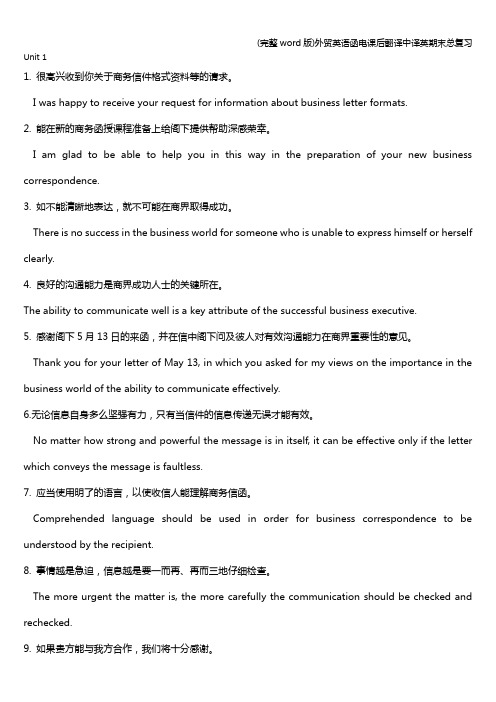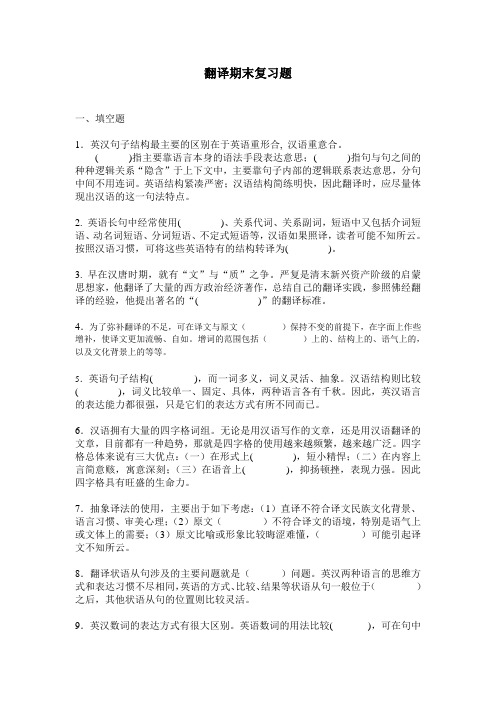翻译课期末复习资料
- 格式:docx
- 大小:22.23 KB
- 文档页数:3

翻译练习9---14参考1、A) She doesn’t wea r her usual lipstick but wears some perfume today.抹口红B) She wears a white dress, an orchid corsage, and a rather lovely, awkward smile.她身穿白色连衣裙,胸前佩戴着淡紫色胸花,脸上露出一丝可爱羞涩的笑容。
C) She wears a permanent smile.她脸上始终带着微笑D) She wears the slimness of her mother. 和她母亲一样苗条E) She really wears her years well. 她保养得非常好.A)我很荣幸代表中国政府和人民向各位外来使节表示热烈欢迎。
I feel honored to express this warm welcome on behalf of Chinese government and people to distinguished diplomatic envoys.B)我以能在此设宴各位贵宾而深感荣幸和愉快。
It is my privilege and great pleasure to host this banquet in honor of all distinguished guests.C)请允许我请各位与我一起举杯,为我们两国的友谊和合作干杯!May I ask you to join me in a toast to the friendship and cooperation between our two countries.A、请问您是来自加拿大的史密斯先生吗?Excuse me, are you Mr. Smith from Canada?A、久闻先生大名,我是加中贸易理事会上海办事处代表。

Unit 11. 很高兴收到你关于商务信件格式资料等的请求。
I was happy to receive your request for information about business letter formats.2. 能在新的商务函授课程准备上给阁下提供帮助深感荣幸。
I am glad to be able to help you in this way in the preparation of your new business correspondence.3. 如不能清晰地表达,就不可能在商界取得成功。
There is no success in the business world for someone who is unable to express himself or herself clearly.4. 良好的沟通能力是商界成功人士的关键所在。
The ability to communicate well is a key attribute of the successful business executive.5. 感谢阁下5月13日的来函,并在信中阁下问及彼人对有效沟通能力在商界重要性的意见。
Thank you for your letter of May 13, in which you asked for my views on the importance in the business world of the ability to communicate effectively.6.无论信息自身多么坚强有力,只有当信件的信息传递无误才能有效。
No matter how strong and powerful the message is in itself, it can be effective only if the letter which conveys the message is faultless.7. 应当使用明了的语言,以使收信人能理解商务信函。

期末考试题翻译题复习资料1 医疗网可以使病人共享信息和相互给予支持。
The medical website enables patients to share information and offer each other support.2 我很高兴你和我们一起去。
你不会因此后悔的。
I am glad you are going with us .You will not regret it.3 那是她所体验过的最奇妙的感觉。
It was the most wonderful feeling she had ever experienced.4 他以科普小说而闻名。
He is known for his popular science novels.5 二十年后他还能清楚地记起这件事。
Twenty years later he could still clearly recall he event.6 那首歌总是让我想起我们的第一次约会。
That song always reminds me of our first date.7 那个建议在会上未引起多大兴趣。
That proposal aroused little enthusiasm at the meeting.8 新来的军官很快赢得了士兵的尊敬。
The new officer soon earned the respect of his soldiers.9 全村很快便人心惶惶了。
Fear spread quickly through the village.10 现在主席要向大会发表演讲。
The chairman will address the meeting.11 好教师总是鼓励学生独立思考。
Good teachers often encourage their students to think for themselves.12 我正想把实际发生的情况告诉他,但他打断了我的话。

⼤⼀英语翻译课(⾮英语专业)期末复习40句⼤⼀英语翻译课(⼤学⾮英语专业)期末复习40句The technique of restructuring1. 我们必须清楚地了解所有牵涉到的问题We must get a clear understanding of the things concerned.2. 她⾮要他讲清楚他的每⼀分钱都到哪⼉去了,他哑⼝⽆⾔。
He was dumb-founded at her insistence that he explain where every cent of his allowance had gone.3. 为了⽣存,为了⾃⼰和⼦孙后代的⾐⾷住⾏,⼈类和⼤⾃然不断进⾏⽃争。
In order to survive, to feed, clothe and shelter himself and his children, man is engaged in a constant struggle with nature. 4. 他的伯⽗于1999年9⽉12⽇凌晨2点30分在医院逝世。
His uncle passed away in hospital at 2:30 a.m. on September 12, 1999.The technique of negation5. ⼯作没有经验,出点差错,在所难免。
Slips are scarcely avoidable when you are new to your work. 6. ⽇⼦很快过去了,她做⼯却丝毫没有放松。
The days passed quickly, but she worked as hard as ever.7.我才不⾄于蠢到相信你所说的⾦钱万能呢。
I’m wiser than to believe what you call money talks.8. 再漂亮的东西,只要仔细观察,也会发现某种缺陷。

翻译技术简明教程期末复习1. 直译法(1) 英译按原文的字面翻译, 其比喻意义同原文一样生动, 译文使读者能很快联想起英文中的对等成语. 如:竭泽而渔to drain a pond to catch all the fish (相当于kill the goose that lays the goldeneggs)2) 打草惊蛇to stir up the grass and alert the snake (相当于wake a sleeping dog)3)易如反掌to be as easy as turning over one’s hand (相当于as easy as falling off a log)4) 玩火自焚to get burnt by the fire kindled by oneself (相当于fry in one’s own grease)5)掌上明珠a pearl in the palm (相当于the apple of one’s eye)6)对牛弹琴to play the lute to a cow (相当于cast pearls before swine)7)守口如瓶to keep one’s mouth closed like a bottle (相当于keep a still tongue in one’s head)8) 雪中送炭to send charcoal in snowy weather (相当于help a lame dog over a stile)9) 画蛇添足to draw a snake and add feet to it (相当于paint the lily)(2) 不少汉语成语不一定有非常对等的英语成语, 但它们的字面翻译也能使译文读者得到正确无误的形象意义. 如:1) 声东击西to shout in the east and strike in the west2) 刻骨铭心to be engraved on one’s heart and bones3)井底之蛙to be like a frog at the bottom of a well4)调虎离山to lure the tiger from the mountain5)口蜜腹剑to be honey-mouthed and dagger-hearted2. 意译法如手忙脚乱in a frantic rush 立竿见影get instant results它虽难以保全成语的文化特色和具体形象却能简洁明快的反应出成语的喻义。

翻译期末复习题一、填空题1.英汉句子结构最主要的区别在于英语重形合, 汉语重意合。
( )指主要靠语言本身的语法手段表达意思;( )指句与句之间的种种逻辑关系“隐含”于上下文中,主要靠句子内部的逻辑联系表达意思,分句中间不用连词。
英语结构紧凑严密;汉语结构简练明快,因此翻译时,应尽量体现出汉语的这一句法特点。
2. 英语长句中经常使用( )、关系代词、关系副词,短语中又包括介词短语、动名词短语、分词短语、不定式短语等,汉语如果照译,读者可能不知所云。
按照汉语习惯,可将这些英语特有的结构转译为( )。
3. 早在汉唐时期,就有“文”与“质”之争。
严复是清末新兴资产阶级的启蒙思想家,他翻译了大量的西方政治经济著作,总结自己的翻译实践,参照佛经翻译的经验,他提出著名的“( )”的翻译标准。
4.为了弥补翻译的不足,可在译文与原文()保持不变的前提下,在字面上作些增补,使译文更加流畅、自如。
增词的范围包括()上的、结构上的、语气上的,以及文化背景上的等等。
5.英语句子结构( ),而一词多义,词义灵活、抽象。
汉语结构则比较( ),词义比较单一、固定、具体,两种语言各有千秋。
因此,英汉语言的表达能力都很强,只是它们的表达方式有所不同而已。
6.汉语拥有大量的四字格词组。
无论是用汉语写作的文章,还是用汉语翻译的文章,目前都有一种趋势,那就是四字格的使用越来越频繁,越来越广泛。
四字格总体来说有三大优点:(一)在形式上( ),短小精悍;(二)在内容上言简意赅,寓意深刻;(三)在语音上( ),抑扬顿挫,表现力强。
因此四字格具有旺盛的生命力。
7.抽象译法的使用,主要出于如下考虑:(1)直译不符合译文民族文化背景、语言习惯、审美心理;(2)原文()不符合译文的语境,特别是语气上或文体上的需要;(3)原文比喻或形象比较晦涩难懂,()可能引起译文不知所云。
8.翻译状语从句涉及的主要问题就是()问题。
英汉两种语言的思维方式和表达习惯不尽相同,英语的方式、比较、结果等状语从句一般位于()之后,其他状语从句的位置则比较灵活。
7.Confucianism & Translating7.1 Confucius(551—479 B.C.), the founder of Confucianism (Tomb of Confucius in Kong Lin cemetery)22)子曰: “吾十有五而立志于学,三十而立,四十而不惑,五十而知天命,六十而耳顺,七十而从心所欲,不逾矩”。
A)The master said: “At fifteen, I had my mind bent on learning. At thirty, I stood firm. At forty, I had no doubts. At fifty, I know the decrees of Heaven. At sixty, my ear was an obedient organ for the reception of truth. At seventy, I could follow what my heart desired, without transgressing what was right. ( James Legge 1814—1897 )B) The Master said: “At fifteen, I set my heart upon learning. At thirty, I had planted my feet firm upon the ground. At forty, I no longer suffered from perplexities. At fifty, I knew what were the biddings of Heaven. At sixty, I heard them with docile ear. At seventy, I could follow the dictates of my own heart; for what I desired no longer overstepped the boundaries of right.”( Arthur Waley 1889-1966)C) Confucius said: “At fifteen, I made up my mind to study; at thirty, I was established; at forty, I was no longer perplexed; at fifty, I understood the will of Heaven; at sixty, I listened to everything without feeling unhappy; at seventy, I followed all my desires and none of them was against the norms.( Ding Wangdao 1924-2010)7.2 Humanity and 8 virtues义、礼、智、信、忠、恕、孝、悌7.3 The AnalectsHumanitarianism & equalityMoralityEducation & knowledgeOthers7.3.1 Humanitarianism & Equality23) “性相近也;习相远也。
翻译概论期末复习1.基本概念(互译)补偿compensation不可译性untranslatability (untranslatable)达/ 易'懂intelligibility/expressiveness等效原则principle of equivalent effect等值翻译equivale nt tran slation动态对等dynamic equivalence读者反映论reader's response读者为中心的翻译标准reader-centered for translation 对等物(词语)equivalent对应(部分对应 / 完全对应)(partial/full ) correspondence翻译程序 /步骤translation procedures翻译体/翻译腔translationese翻译学translatology/Translation Studies风格style佛经Buddhist Scriptures/sutra符际翻译intersemiotic translation改变说法rewording功能对等functional equivale nee归化domestication/naturalization/adaptation/endogenization/target-accommodating translation 机器翻译machine translation (MT)交际翻译communicative translation 交替口译consecutive interpreting 解码decode 可译性translatability (translatable)理解understanding/comprehension 流畅fluency 舌L译 / 胡译excessively free translation 明析化explicitation 模仿imitation 目的论skopostheorie 诗学poetics 视点转换shift of perspective 释义法 /解释法explanation/paraphrase 死译/ 硬译mechanical translation 套译/仿译/仿拟imitation通顺smoothness同声传译simultaneous interpreting透明(度)transparency歪译(意义扭曲)distortion伪译pseudotranslation文本text 文本等值textual equivalence 文本为中心的翻译标准text-centered criteria for translation 文化沟(空缺/非对应)cultural gap误译mis・translation 信/ 忠实faithfulness/fidelity 形合hypotaxis 形式对等formal equivalence 形式对应formal correspondence 雅/ 优美elegance/gracefulness 异彳匕foreignization/alienation/exoticization/ exogenization/source-oriented translation 译本 / 译著translated text/translational work 译借(语义转借)calque(loan translation)译文target text, translation, target version, rendering, rendition译语 / 译入语target language(TL), receptor language, receiving language 译语读者target-language reader/TLreader/receiving audienee 译语文彳匕target-language culture/target culture/receiving culture 译者为中心的翻译标准translator-centered criteria for translation 译者隐形translator * s invisibility 意合parataxis 意识形态ideology意译free translation/liberal translation/semantic translation 音译法transliteration 语际翻译interlingual tran slati on 语境con text语内翻译intralingual translation 语义翻译semantic translation 原文 / 原著source text (ST), SL text, original text, original version/original work 原彳乍者SL author, original author 源语 / 译出语source language(SL), original language 源语读者source-language reader/SL reader 源语文化source・ language culture/source culture 纟勺定俗成conve ntion 再现reproduction/representatio n 赞助patron age 直译literal translation/direct translation 逐字译word-for-wordtranslation/worcMoword substitution/verbatim translation 注释性翻译armotated/commented translation 专业人士professionals 转换transformation 自然naturalness/idiomaticity 综合法mixture of methods2.翻译理论家及其理论信达雅faithfulness 、 expressiveness and eleganee长期被我国广大译者视为翻译标准。
英汉对比与翻译概论期末复习指南Cha. 1一、汉语的注音⏹汉语是象形文字,不具有表音的作用。
⏹历史上曾有过多种为汉字注音的尝试,如:❑直音:午,音五。
❑反切:力,了一切。
∴王力→王了一❑注音字母(1918):ㄅㄆㄇㄈㄉㄊㄋㄌ(bpmfdtnl)❑Wade-Giles (威妥玛–翟理斯式拼音法,简称威氏拼音法, 1867/1912): Mao Tse-tung, Chou Enlai❑汉语拼音(1958/1978):Mao Zedong, Zhou Enlai❑2009年初台湾宣布采用汉语拼音二、英语的注音⏹国际音标⏹KK音标⏹韦氏音标Cha. 2一、音译⏹音译法⏹是用一种语言文字写出或读出另一种语言的词或词组的发音而引入吸收新词的一种主要方法。
❑音译法常用来翻译专有名词(人名、地名),但有些外来商品的商标,部分书名、电影、电视剧、戏剧名,科技发明创造,以及某些新生事物所产生的新词语也采用音译法。
❑音译往往是不得已而为之,音译过来的东西往往无法从字面上看出其内涵,有时译文会使读者产生文化隔膜,导致理解上的困难。
⏹全音译:⏹指全部按照英语单词的发音来选择汉字表达的翻译方法。
❑这种译法很有异国情调,给人以新鲜感,时髦感,体现时代精神,紧跟时代潮流。
⏹analgin 安乃近⏹Bisquit 百事吉⏹copy 拷贝⏹Delicious 得利斯⏹Fiyta 飞亚达⏹Kodak 柯达⏹Ford 福特⏹Lactov 乐口福⏹Lucky 乐凯⏹Paloma 百乐满⏹party 派对⏹Polaroid 宝利莱⏹salad 色拉⏹shampoo 香波⏹toast 吐司⏹部分音译部分意译:⏹指在英语名词音译前或后再加上说明性文字,让人们知道该名称的性质是什么。
❑但随着该词的流行和接受程度,意译部分逐渐淘汰,弃而不用。
⏹B owling 保龄球⏹Cookies 曲奇饼⏹Clean & Clear 可伶可俐洗面奶⏹Disco 迪斯科舞⏹Jacket 夹克衫⏹Golf 高尔夫球⏹Good 古德面包⏹Head & Shoulders 海飞丝洗发露⏹Jeep 吉普车⏹More 摩尔香烟⏹Pizza 比萨饼⏹Safeguard 舒肤佳香皂⏹Sardine 沙丁鱼罐头⏹Toffee 太妃糖⏹Top 脱普洗头膏⏹Sony 索尼电器⏹Waltz 华尔兹舞⏹约定俗成的译名不应重新改译,最好尽量保留原译名。
浙江广播电视大学英语专业(开放专科)《英语翻译基础》期末复习一、考试题型和模拟题1. 选择题:10题,每题2分,共20分。
范围主要包括翻译标准,直译与意译问题,翻译的定义,文化与翻译的问题。
2. 问答题:1题,共10分。
范围主要包括直译与意译问题,翻译的标准,以及翻译与文化的关系等等。
3.改译句子:10题,共30分。
3. 段落翻译(英译汉):2段,共40分。
一、选择题(在四个选项中选择一个正确答案):1. 明朝末年的翻译家徐光启主要从事--- ---的翻译。
A. 佛教经典B. 文学作品C. 科技著作D. 哲学著作2. 《马氏文通》的作者马建忠提出了“--- ---”的翻译观点。
A. 善译B. 化境C. 神似D. 信、达、雅3. 出版后即风靡海内的《巴黎茶花女遗事》是-- ----的译作。
A.严复 B. 林纾C. 林语堂D. 梁实秋4.“意译”是指译文从意义出发,要求将原文的意义正确表达出来,不必拘泥于-- ----的形式。
A. 词句B. 词句和比喻C. 各种修辞手段D. 词、句、以及各种修辞手段5. 翻译是一种()的交际活动。
A.跨语言,跨文化,跨社会 B. 跨语言C.跨语言,跨社会 D. 跨语言,跨社会6. 翻译的理想单位是:__________。
()A.篇章 B. 句子 C.词语 D. 单词7.下列四个语言特点中,---- --不是广告英语的特点。
A. 多祈使句B. 多后置定语C. 多新词汇D. 多常用词汇8. 鲁迅曾提出过“------- --------”的翻译观点。
A. 宁顺而不信B. 宁信而不顺C. 与其信而不顺,不如顺而不信D. 忠实、通顺、得体9.“Do you see any green in my eye?”可以翻译为:__ _____。
A. 你从我的眼睛里看到绿颜色吗?B. 你以为我是好欺骗的吗?C. 你从我的眼睛里看到嫉妒的感觉吗?D. 你以为我在嫉妒你吗?10. “Last night I heard him driving his pigs to market.” 意思为( )。
翻译课期末复习资料一.词组翻译(10*1`)
二.改错(5*2`)
三.句子翻译(10*2`)
四.Cloze(10*2`)
五.段落翻译(1*50`)
一.词组翻译(10*1`)
•浓茶
•strong tea
•美术馆
•art gallery
•展览馆
•exhibit hall
•打的
•take a taxi
•白卷
•unanswered test paper
•红茶
•black tea
•假钞
•counterfeit money; forged note •礼仪小姐
•ritual girl
•基本工资
•basic salary •基本设施
•infrastructure
•浓烟
•dense smoke
•美术馆
•art gallery
•展览馆
•exhibit hall
•打水
•fetch water
•白丁
•illiterate person
•红利
•bonus
•假钞
•counterfeit money; forged note •假花
•artificial flower
三.句子翻译
•我愿与你共甘共苦。
•I want to share your ups and downs.
•如此恶毒的谎言不啻暗箭伤人。
•Such a vicious lie could be nothing but a stab in the back.
•对他那号人你还是敬而远之为妙。
•You’d better give a wide berth to a guy of his sort.
•我没有添油加醋,我说的都是事实。
•I didn’t spice up. All I said is true.
•他在会议上的讲话有点喧宾夺主了。
•His speech at the meeting seemed to have stolen the show.
•那个歌星也只是昙花一现,除了两张唱片就销声匿迹了。
•That singer was only a flash in the pan. He disappeared into the air after having released two albums.
•他试几次都失败了,所以现在也只能听天由命了。
•He failed all his attempts and now he has to resign to his fate.
•如今木已成舟,你再反对又有什么用?
•Now the die is already cast, what’s the point of standing against it?
•志向高远是好事,但光有远大的志向是不够的。
•It’s great to hitch your wagon to a star, but that alone is not enough.
•他的妻子威胁说要跟他离婚,从此他决定改邪归正。
•After his wife threatened him with divorce, he decided to straighten up and fly right.
•多数人兴高采烈之日,却是少数人伤心失意之时
•For most ( of the people ), it is a day of happiness; for some( of the people ), sadness.
•外交人员应该立场坚定、目光远大、头脑敏捷、业务熟练、才华出众、风格高尚。
•The diplomats should be firm in stand, far-sighted in vision, swift in mind, proficient in talent, noble in personality.
四.Cloze
《论语》一开头就记载着孔子的教导:“有朋自远方来,不亦乐乎?”孔子这句话包含了极丰富的意蕴,对于我们今天理解和阐明中国文化的根本精神有重要的价值。
“远方”暗示着生活方式和思想观念的差异。
中国人向来把来自远方的人当做可尊敬的朋友来看待,并且真诚地相信他们身上必有值得学习借鉴的地方。
同时,中国人也希望自己的文化在与外人面前也能展示一种魅力。
《论语》有一段重要的记载:“叶公问政。
子曰:近者悦,远者来。
”这就说,一个国家的政治搞得好,应该使你的近邻欢乐,还要使远方的人们仰慕你的文化,到你这里来观摩学习。
The Analects (Lunyu)begins (begin) with the Confuciu s edict: “Is it not a pleasure to meet (meet)friends from afar?” The rich connotation implied in these words is of great value to our understanding and illumination of the essential spirit of Chinese culture today. “Afar” implies (imply) difference in ways of life and ideology. Confucius’s attitude shows (show) that the Chinese have always highly respected (respect) friends from a long way off and aspired to learn (aspire, learn ) from them. At the same time, there existed (exist) the wish to present (present) charm to the outsiders. There is an important record from The Analects:” Magistrate of the Ye County asked (ask) about governance. Confucius replied (reply): Good governance makes (make) one’s neighbors happy and attracts(attract) people from faraway places.” It means that if
well-governed your country will delight the neighboring countries and attract the people afar to admire your culture and to come and learn(come, learn) from you.
《老子》又称《道德经》,只有五千多个汉字,共81章,分为道篇和德篇两部分。
虽然简短,但它在中国文化发展中的作用却很大:以它为基础,中国古代产生了与儒家并列的哲学派别道家;根据它的思想,中国古代产生了以老子为始祖的宗教派别道教,这是华夏民族本土产生的最具影响的宗教。
《老子》在15世纪左右就开始被介绍到欧洲,它是译本最多的中国古代哲学著作之一。
老子哲学的核心是自然无为,围绕这一核心,老子提出了许多极富启发意义的观点。
Laozi, also known (know) as Classic of the Way and Virtue (Dao De Jing), consists (consist) of just over 5,000 characters. Its 81 chapters are divided (divide) into two parts, Dao (the Way) and De (Virtue). Brief as it is, the book has played (play) a tremendous role in the development of Chinese culture. It served as/ became(become) the basis of Taoism, the school of philosophy parallel to Confucianism in ancient China. According to its thoughts, Taoism, the most influential indigenous school of religion in China, came into being with Laozi as its first ancestor. Laozi was first introduced (introduce) into Europe in about the 15th century and has been (be) one of the most widely translated philosophical works of ancient China. Many of Laozi’s enlightening views are based ( base) on the core of his philosophy: naturalness and non-action.。